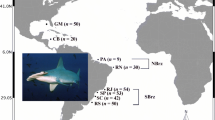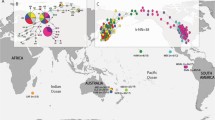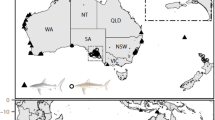Abstract
The Galapagos shark (Carcharhinus galapagensis) is one of over thirty shark species inhabiting the Galápagos Marine Reserve (GMR), where it is a priority species for conservation. Identifying stock structure and effective population size for species-specific management and effective conservation of this top predator is important. We examined stock structure, connectivity and effective population size of Galapagos sharks among GMR locations using genome-wide neutral Single Nucleotide Polymorphism (8103 SNP) and mtDNA markers. Potential historical gene flow and/or sex-biased dispersal were also examined using the mitochondrial control region (997 bp). Cluster analyses of neutral SNPs revealed two differentiated stocks in the GMR—a western (Isabela Island) and eastern (San Cristóbal and Santa Cruz Islands) stock. Effective population size (Ne) estimates of approximately 200 suggest these populations are susceptible to ongoing natural and anthropogenic stressors and are of concern for long term resilience of populations. Mitochondrial DNA failed to identify distinct stocks, with AMOVA analyses indicating most genetic variation occurs within, rather than among locations. This pattern of genome-wide nuclear (but not mtDNA) discrimination among neighbouring islands either points to possible sex-biased dispersal by females or identifies limitations of the single organelle mtDNA marker at such small spatial scales. Regional differences across the archipelago or in behaviour may be implicated in the observed population structure. Further research focusing on a larger, Pacific wide analysis of population connectivity and effective population size at a broader spatial scale is required, to estimate the extent of discreteness and potential local adaptation. Potential adaptive units (AUs) in Galapagos sharks should ultimately be identified to leverage adaptive management and fisheries forensics applications.



Similar content being viewed by others
References
Allendorf FW, Hohenlohe PA, Luikart G (2010) Genomics and the future of conservation genetics. Nat Rev Genet 11:697–709. doi:10.1038/nrg2844
Antao T, Lopes A, Lopes RJ, et al (2008) LOSITAN: A workbench to detect molecular adaptation based on a Fst-outlier method. BMC Bioinform 9:323. doi:10.1186/1471-2105-9-323
Antao T, Pérez-Figueroa A, Luikart G (2011) Early detection of population declines: high power of genetic monitoring using effective population size estimators. Evol Appl 4:144–154. doi:10.1111/j.1752-4571.2010.00150.x
Barbieri M, Maltagliati F, Roldán MI, Castelli A (2014) Molecular contribution to stock identification in the small-spotted catshark, Scyliorhinus canicula (Chondrichthyes, Scyliorhinidae). Fish Res 154:11–16. doi:10.1016/j.fishres.2014.01.021
Baum JK, Myers RA, Kehler DG et al (2003) Collapse and conservation of shark populations in the northwest Atlantic. Science 299:389–392. doi:10.1126/science.1079777
Belkhir K, Borsa P, Chikhi L, et al (2004) GENETIX 4.05, logiciel sous Windows TM pour la génétique des populations.
Bennett M, Gordon I, Kyne PM (2003) SSG Australia & Oceania regional rorkshop, March 2003. Carcharhinus galapagensis. The IUCN Red List of Threatened Species. Version 2014.1. http://www.iucnredlist.org
Bensted-Smith R (2002) A biodiversity vision for the Galapagos Islands. In: Danulat E, Edgar GJ (eds) Reserva Marina de Galápagos. Línea base de la biodiversidad. Fundación Charles Darwin, Galápagos, Ecuador, pp 60–69
Blower DC, Riginos CR, Ovenden JR (in preparation) NeOGen: a tool to predict genetic effective population size (Ne) for low-fecundity, slowly-maturing, iteroparous species, and to assist empirical Ne study design
Camhi M, Fowler S, Musick JA, et al (1998) Sharks and their relatives: ecology and conservation. IUCNSSC Shark Spec Group IUCN Gland Switz Camb UK iv-39.
Carreras-Carbonell J, Macpherson E, Pascual M (2006) Population structure within and between subspecies of the Mediterranean triplefin fish Tripterygion delaisi revealed by highly polymorphic microsatellite loci. Mol Ecol 15:3527–3539. doi:10.1111/j.1365-294X.2006.03003.x
Compagno LJ (1984) FAO species catalogue, Sharks of the world: an annotated and illustrated catalogue of shark species known to date. Part 2. Carcharhiniformes. FAO Fish Synop 125:251–655
Cortés E (2000) Life history patterns and correlations in sharks. Rev Fish Sci 8:299–344. doi:10.1080/10408340308951115
Do C, Waples RS, Peel D, et al (2014) NeEstimator v2: re-implementation of software for the estimation of contemporary effective population size (Ne) from genetic data. Mol Ecol Resour 14:209–214. doi:10.1111/1755-0998.12157
Dulvy NK, Baum JK, Clarke S et al (2008) You can swim but you can’t hide: the global status and conservation of oceanic pelagic sharks and rays. Aquat Conserv Mar Freshw Ecosyst 18:459–482. doi:10.1002/aqc.975
Dulvy NK, Fowler SL, Musick JA et al (2014) Extinction risk and conservation of the world’s sharks and rays. eLife 3:e00590. doi:10.7554/eLife.00590
Duncan KM, Martin AP, Bowen BW, De Couet HG (2006) Global phylogeography of the scalloped hammerhead shark (Sphyrna lewini). Mol Ecol 15:2239–2251. doi:10.1111/j.1365-294X.2006.02933.x
Earl DA, vonHoldt BM (2011) STRUCTURE HARVESTER: a website and program for visualizing STRUCTURE output and implementing the Evanno method. Conserv Genet Resour 4:359–361. doi:10.1007/s12686-011-9548-7
Edgar GJ, Banks S, Fariña JM et al (2004) Regional biogeography of shallow reef fish and macro-invertebrate communities in the Galapagos archipelago. J Biogeogr 31:1107–1124. doi:10.1111/j.1365-2699.2004.01055.x
Evanno G, Regnaut S, Goudet J (2005) Detecting the number of clusters of individuals using the software structure: a simulation study. Mol Ecol 14:2611–2620. doi:10.1111/j.1365-294X.2005.02553.x
Excoffier L, Smouse PE, Quattro JM (1992) Analysis of molecular variance inferred from metric distances among DNA haplotypes: application to human mitochondrial DNA restriction data. Genetics 131:479–491
Excoffier L, Laval G, Schneider SS (2005) Arlequin (version 3.0): An integrated software package for population genetics data analysis
Franklin IR, Frankham R (1998) How large must populations be to retain evolutionary potential? Anim Conserv 1:69–70. doi:10.1111/j.1469-1795.1998.tb00228.x
Garber AF, Tringali MD, Franks JS (2005) Population genetic and phylogeographic structure of wahoo, Acanthocybium solandri, from the western central Atlantic and central Pacific Oceans. Mar Biol 147:205–214. doi:10.1007/s00227-004-1533-1
Garvin MR, Saitoh K, Gharrett AJ (2010) Application of single nucleotide polymorphisms to non-model species: a technical review. Mol Ecol Resour 10:915–934. doi:10.1111/j.1755-0998.2010.02891.x
Gilbert KJ, Whitlock MC (2015) Evaluating methods for estimating local effective population size with and without migration. Evolution Int J org Evolution 69:2154–2166. doi:10.1111/evo.12713
Grant WAS, Bowen BW (1998) Shallow population histories in deep evolutionary lineages of marine fishes: insights from sardines and anchovies and lessons for conservation. J Hered 89:415–426. doi:10.1093/jhered/89.5.415
Grewe PM, Feutry P, Hill PL et al (2015) Evidence of discrete yellowfin tuna (Thunnus albacares) populations demands rethink of management for this globally important resource. Sci Rep 5:16916. doi:10.1038/srep16916
Hare MP, Nunney L, Schwartz MK et al (2011) Understanding and estimating effective population size for practical application in marine species management. Conserv Biol 25:438–449. doi:10.1111/j.1523-1739.2010.01637.x
Hearn AR, Acuña D, Ketchum D et al (2014) Elasmobranchs of the Galapagos Marine Reserve. In: Denkinger J, Vinueza L (eds) The Galapagos Marine Reserve: a dynamic socio-ecological system. Springer, New York, pp 23–59
Heist EJ, Musick JA, Graves JE (1996) Genetic population structure of the shortfin mako (Isurus oxyrinchus) inferred from restriction fragment length polymorphism analysis of mitochondrial DNA. Can J Fish Aquat Sci 53:583–588. doi:10.1139/f95-245
Helyar SJ, Hemmer-Hansen J, Bekkevold D et al (2011) Application of SNPs for population genetics of nonmodel organisms: new opportunities and challenges. Mol Ecol Resour 11:123–136. doi:10.1111/j.1755-0998.2010.02943.x
Heupel MR, Knip DM, Simpfendorfer CA, Dulvy NK (2014) Sizing up the ecological role of sharks as predators. Mar Ecol Prog Ser 495:291–298. doi:10.3354/meps10597
Heylings P, Bensted-Smith R, Altamirano M (2002) Zonificación e historia de la Reserva Marina de Galápagos. In: Danulat E, Edgar GK (eds) Reserva Marina de Galápagos Línea base de la biodiversidad. Fundación Charles Darwin/Parque Nacional Galápagos. Galápagos, Santa Cruz, pp 4–7
Hill WG (1981) Estimation of effective population size from data on linkage disequilibrium. Genet Res 38:209–216. doi:10.1017/S0016672300020553
Houvenaghel GT (1978) Oceanographic conditions in the Galápagos Archipelago and their relationships with life on the islands. In: Boje R, Tomczak M (eds) Upwelling Ecosystems. Springer, Berlin, pp 181–200
Huelsenbeck JP, Ronquist F, Nielsen R, Bollback JP (2001) Bayesian inference of phylogeny and Its impact on evolutionary biology. Science 294:2310–2314
Jacquet J, Alava JJ, Pramod G et al (2008) In hot soup: sharks captured in Ecuador’s waters. Environ Sci 5:269–283. doi:10.1080/15693430802466325
Jennings S (2000) Patterns and prediction of population recovery in marine reserves. Rev Fish Biol Fish 10:209–231. doi:10.1023/A:1016619102955
Jombart T, Ahmed I (2011) adegenet 1.3–1: new tools for the analysis of genome-wide SNP data. Bioinformatics 27:3070–3071. doi:10.1093/bioinformatics/btr521
Kearse M, Moir R, Wilson A et al (2012) Geneious Basic: An integrated and extendable desktop software platform for the organization and analysis of sequence data. Bioinformatics 28:1647–1649. doi:10.1093/bioinformatics/bts199
Keeney DB, Heupel M, Hueter RE, Heist EJ (2003) Genetic heterogeneity among blacktip shark, Carcharhinus limbatus, continental nurseries along the U.S. Atlantic and Gulf of Mexico. Mar Biol 143:1039–1046. doi:10.1007/s00227-003-1166-9
Keeney DB, Heupel MR, Hueter RE, Heist EJ (2005) Microsatellite and mitochondrial DNA analyses of the genetic structure of blacktip shark (Carcharhinus limbatus) nurseries in the northwestern Atlantic, Gulf of Mexico, and Caribbean Sea. Mol Ecol 14:1911–1923. doi:10.1111/j.1365-294X.2005.02549.x
Ketchum JT, Hearn A, Klimley AP et al (2014a) Seasonal changes in movements and habitat preferences of the scalloped hammerhead shark (Sphyrna lewini) while refuging near an oceanic island. Mar Biol 161:755–767. doi:10.1007/s00227-013-2375-5
Ketchum JT, Hearn A, Klimley AP et al (2014b) Inter-island movements of scalloped hammerhead sharks (Sphyrna lewini) and seasonal connectivity in a marine protected area of the eastern tropical Pacific. Mar Biol 161:939–951. doi:10.1007/s00227-014-2393-y
Kohler NE, Casey JG, Turner PA (1998) NMFS cooperative shark tagging program, 1962–1993: an atlas of shark tag and recapture data. Mar Fish Rev 60:1–87
Lamichhaney S, Barrio AM, Rafati N et al (2012) Population-scale sequencing reveals genetic differentiation due to local adaptation in Atlantic herring. Proc Natl Acad Sci U S A 109:19345–19350
Lanfear R, Calcott B, Ho SYW, Guindon S (2012) PartitionFinder: combined selection of partitioning schemes and substitution models for phylogenetic analyses. Mol Biol Evol 29:1695–1701. doi:10.1093/molbev/mss020
Larson WA, Seeb LW, Everett MV et al (2014) Genotyping by sequencing resolves shallow population structure to inform conservation of Chinook salmon (Oncorhynchus tshawytscha). Evol Appl 7:355–369. doi:10.1111/eva.12128
Lischer HEL, Excoffier L (2012) PGDSpider: an automated data conversion tool for connecting population genetics and genomics programs. Bioinformatics 28:298–299. doi:10.1093/bioinformatics/btr642
Luikart G, Ryman N, Tallmon DA et al (2010) Estimation of census and effective population sizes: the increasing usefulness of DNA-based approaches. Conserv Genet 11:355–373. doi: 10.1007/s10592-010-0050-7
Lynch M, Lande R (1998) The critical effective size for a genetically secure population. Anim Conserv 1:70–72. doi:10.1111/j.1469-1795.1998.tb00229.x
Martin AP, Naylor GJP, Palumbi SR (1992) Rates of mitochondrial DNA evolution in sharks are slow compared with mammals. Nature 357:153–155
Mcmillan WO, Palumbi SR (1995) Concordant evolutionary patterns among Indo-West Pacific butterflyfishes. Proc Biol Sci 260:229–236
Moura AE, Kenny JG, Chaudhuri R et al (2014) Population genomics of the killer whale indicates ecotype evolution in sympatry involving both selection and drift. Mol Ecol 23:5179–5192. doi:10.1111/mec.12929
Murillo JC, Reyes H, Zárate P et al (2004) Evaluación de la captura incidental durante el plan piloto de pesca de altura con palangre en la Reserva Marina de Galápagos. Dirección del Parque Nacional Galápagos
Nei M (1987) Genetic distance and molecular phylogeny. Popul Genet Fish Manag Seattle, USA, pp.193–223
Nei M, Li WH (1979) Mathematical model for studying genetic variation in terms of restriction endonucleases. Proc Natl Acad Sci USA 76:5269–5273
Newman D, Pilson D (1997) Increased probability of extinction due to decreased genetic effective population size: experimental populations of Clarkia pulchella. Evol Int J Org Evol 51:354–362. doi:10.2307/2411107
Nielsen EE, Hemmer-Hansen J, Poulsen NA et al (2009) Genomic signatures of local directional selection in a high gene flow marine organism; the Atlantic cod (Gadus morhua). BMC Evol Biol 9:276. doi:10.1186/1471-2148-9-276
Ouborg NJ, Pertoldi C, Loeschcke V et al (2010) Conservation genetics in transition to conservation genomics. Trends Genet 26:177–187. doi:10.1016/j.tig.2010.01.001
Ovenden JR, Kashiwagi T, Broderick D et al (2009) The extent of population genetic subdivision differs among four co-distributed shark species in the Indo-Australian archipelago. BMC Evol Biol 9:40. doi:10.1186/1471-2148-9-40
Palstra FP, Ruzzante DE (2008) Genetic estimates of contemporary effective population size: what can they tell us about the importance of genetic stochasticity for wild population persistence? Mol Ecol 17:3428–3447. doi:10.1111/j.1365-294X.2008.03842.x
Palstra FP, O’connell MF, Ruzzante DE (2007) Population structure and gene flow reversals in Atlantic salmon (Salmo salar) over contemporary and long-term temporal scales: effects of population size and life history. Mol Ecol 16:4504–4522. doi:10.1111/j.1365-294X.2007.03541.x
Pardini AT, Jones CS, Noble LR et al (2001) Sex-biased dispersal of great white sharks. Nature 412:139–140. doi: 10.1038/35084125
Pilot M, Dahlheim ME, Hoelzel AR (2010) Social cohesion among kin, gene flow without dispersal and the evolution of population genetic structure in the killer whale (Orcinus orca). J Evol Biol 23:20–31. doi:10.1111/j.1420-9101.2009.01887.x
Planes S, Fauvelot C (2002) Isolation by distance and vicariance drive genetic structure of a coral reef fish in the Pacific Ocean. Evol Int J org Evol 56:378–399
Portnoy DS, Mcdowell JR, Heist EJ et al (2010) World phylogeography and male-mediated gene flow in the sandbar shark, Carcharhinus plumbeus. Mol Ecol 19:1994–2010. doi:10.1111/j.1365-294X.2010.04626.x
Portnoy DS, Puritz JB, Hollenbeck CM et al (2015) Selection and sex-biased dispersal in a coastal shark: the influence of philopatry on adaptive variation. Mol Ecol 24:5877–5885. doi:10.1111/mec.13441
Pritchard JK, Wen W (2003) Documentation for structure software: Version 2. http://pritch.bsd.uchicago.edu.elibrary.jcu.edu.au.
Pritchard JK, Stephens M, Donnelly P (2000) Inference of population structure using multilocus genotype data. Genetics 155:945–959
Purcell S, Neale B, Todd-Brown K et al (2007) PLINK: A tool set for whole-genome association and population-based linkage analyses. Am J Hum Genet 81:559–575
R Development Core Team (2008) R: a language and environment for statistical computing. R foundation for statistical computing, Vienna. http://www.R-project.org
Rambaut A, Suchard MA, Xie D, Drummond A (2014) Tracer v1.6, http://beast.bio.ed.ac.uk/Tracer.
Reyes H, Salinas-de-León P, Banda G et al (2014) Plan Piloto de Pesca de Altura con arte de pesca “Empate Oceanico Modificado” en la Reserva Marina de Galápagos. Dirección del Parque Nacional Galápagos, Puerto Ayora, Galapagos
Rodríguez-Ramilo ST, Wang J (2012) The effect of close relatives on unsupervised Bayesian clustering algorithms in population genetic structure analysis. Mol Ecol Resour 12:873–884. doi:10.1111/j.1755-0998.2012.03156.x
Rus Hoelzel A, Shivji MS, Magnussen J, Francis MP (2006) Low worldwide genetic diversity in the basking shark (Cetorhinus maximus). Biol Lett 2:639–642. doi:10.1098/rsbl.2006.0513
Salinas-de-León P, Acuña-Marrero D, Rastoin E et al (2016) Largest global shark biomass found in the northern Galápagos Islands of Darwin and Wolf. Peer J. doi:10.7717/peerj.1911
Sansaloni CP, Petroli CD, Carling J et al (2010) A high-density Diversity Arrays Technology (DArT) microarray for genome-wide genotyping in Eucalyptus. Plant Methods 6:16. doi:10.1186/1746-4811-6-16
Sansaloni C, Petroli C, Jaccoud D et al (2011) Diversity Arrays Technology (DArT) and next-generation sequencing combined: genome-wide, high throughput, highly informative genotyping for molecular breeding of Eucalyptus. BMC Proc 5:54. doi:10.1186/1753-6561-5-S7-P54
Simpfendorfer CA (2000) Predicting population recovery rates for endangered western Atlantic sawfishes using demographic analysis. Environ Biol Fishes 58:371–377. doi:10.1023/A:1007675111597
Smoot ME, Ono K, Ruscheinski J et al (2011) Cytoscape 2.8: new features for data integration and network visualization. Bioinformatics 27:431–432. doi:10.1093/bioinformatics/btq675
Steinig EJ, Neuditschko M, Khatkar MS et al (2016) Netview p: a network visualization tool to unravel complex population structure using genome-wide SNPs. Mol Ecol Resour 16:216–227. doi:10.1111/1755-0998.12442
Stevens JD, Bonfil R, Dulvy NK, Walker PA (2000) The effects of fishing on sharks, rays, and chimaeras (chondrichthyans), and the implications for marine ecosystems. ICES J Mar Sci J Cons 57:476–494. doi:10.1006/jmsc.2000.0724
Stow AJ, Zenger KR, Briscoe D et al (2006) Isolation and genetic diversity of endangered grey nurse shark (Carcharias taurus) populations. Biol Lett 2:308–311. doi:10.1098/rsbl.2006.0441
Sundqvist L, Keenan K, Zackrisson M et al (2016) Directional genetic differentiation and asymmetric migration. Ecol Evol 6:3461–3475. doi:10.1002/ece3.2096
Sunnucks P, Hales DF (1996) Numerous transposed sequences of mitochondrial cytochrome oxidase I-II in aphids of the genus Sitobion (Hemiptera: Aphididae). Mol Biol Evol 13:510–524
Taguchi M, King JR, Wetklo M, et al (2015) Population genetic structure and demographic history of Pacific blue sharks (Prionace glauca) inferred from mitochondrial DNA analysis. Mar Freshw Res 66:267–275. doi:10.1071/MF14075
Tamura K, Dudley J, Nei M, Kumar S (2007) MEGA4: molecular evolutionary genetics analysis (MEGA) software version 4.0. Mol Biol Evol 24:1596–1599. doi:10.1093/molbev/msm092
van Herwerden L, Almojil D, Choat H (2008) Population genetic structure of Australian Galápagos reef sharks Carcharhinus galapagensis at Elizabeth and Middleton Reefs Marine National Nature Reserve and Lord Howe Island Marine Park. Final report to the Department of the Environment, water, heritage and the arts. Queensland, Australia
Walsh MR, Munch SB, Chiba S, Conover DO (2006) Maladaptive changes in multiple traits caused by fishing: impediments to population recovery. Ecol Lett 9:142–148. doi:10.1111/j.1461-0248.2005.00858.x
Waples RS, Anderson EC (2017) Purging putative siblings from population genetic data sets: a cautionary view. Mol Ecol 26:1211–1224. doi:10.1111/mec.14022
Ward RD (2000) Genetics in fisheries management. Hydrobiologia 420:191–201. doi:10.1023/A:1003928327503
Wetherbee BM, Crow GL, Lowe CG (1996) Biology of the Galapagos shark, Carcharhinus galapagensis, in Hawaii. Environ Biol Fishes 45:299–310. doi:10.1007/BF00003099
White WM, McBirney AR, Duncan RA (1993) Petrology and geochemistry of the Galápagos Islands: portrait of a pathological mantle plume. J Geophys Res Solid Earth 98:19533–19563. doi:10.1029/93JB02018
Wolf JB, Harrod C, Brunner S et al (2008) Tracing early stages of species differentiation: ecological, morphological and genetic divergence of Galápagos sea lion populations. BMC Evol Biol 8:150. doi:10.1186/1471-2148-8-150
Wolff M, Ruiz DJ, Taylor M (2012) El Niño induced changes to the bolivar channel ecosystem (Galapagos): comparing model simulations with historical biomass time series. Mar Ecol Prog Ser 448:7–22. doi:10.3354/meps09542
Zimmerhackel JS, Schuhbauer AC, Usseglio P et al (2015) Catch, bycatch and discards of the Galapagos Marine Reserve small-scale handline fishery. Peer J. doi:10.7717/peerj.995
Acknowledgements
We are extremely grateful to M Pazmiño, E Espinosa, F Córdova, LR Nieto, E Noboa, B Noboa, W Buenaño, C Tomalá, M Córdova, and other fishermen and field assistants who generously cooperated with us during sample collection. Special thanks to the Galápagos National Park for their support with samples and permits to collect and export samples from the Galápagos Islands (permit number 065-2013PNG). For laboratory, analytical, and logistic support we thank M Green, R Basita, DA Ortiz, D Alarcón, NA Andrade and M Hirschfeld. We thank the Ecuadorian Government, who funded this research through the National Secretary of Higher Education, Science and Technology (SENESCYT) scholarship; and to EcoCiencia foundation, which funded part of the project by an EcoFondo grant.
Author information
Authors and Affiliations
Corresponding author
Electronic supplementary material
Below is the link to the electronic supplementary material.
Rights and permissions
About this article
Cite this article
Pazmiño, D.A., Maes, G.E., Simpfendorfer, C.A. et al. Genome-wide SNPs reveal low effective population size within confined management units of the highly vagile Galapagos shark (Carcharhinus galapagensis). Conserv Genet 18, 1151–1163 (2017). https://doi.org/10.1007/s10592-017-0967-1
Received:
Accepted:
Published:
Issue Date:
DOI: https://doi.org/10.1007/s10592-017-0967-1




